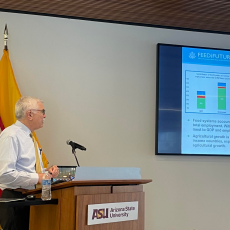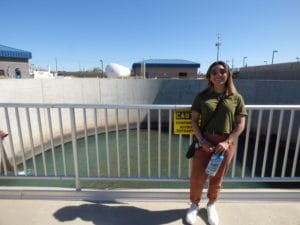
Student spotlight: Shrut Kirti Chawla
To highlight some of Project Cities' star students, PC staff sat down to interview Shrut Kirti Chawla, a recent master’s graduate from The Polytechnic School Environmental and Resource Management program!

USAID Feed the Future: More important than ever
On Tuesday, May 10th, the United States Agency for International Development (USAID) Chief Scientist for Resilience and Food Security, Dr. Rob Bertram, came to the ASU campus in Washington D.C., where I had the privilege of being amongst the Sustainable Food Systems graduate students to hear him speak. He explained the history and work of the Feed the Future program, the U.S. government’s global hunger and food security initiative, and the challenges that lie ahead in combating global hunger.

August 2022 newsletter on how to build a corporate green team
Our August newsletter features a how-to guide for creating your very first green team at your workplace, plus the essential guide to sustainable living. Also read about the successful launch

Industry perspectives on influencing the food system
Before my visit to our nation’s capital for our food policy course, my opinion regarding lobbyists, admittedly from an uninformed perspective, was of someone paid to push their company’s product or issue ahead of others. I didn’t know what it took to have a voice on Capitol Hill that carried weight to influence real change.

New summary report released: Novel Applications for Fine Glass
As a leader in sustainable solid waste, the City of Peoria is always on the cutting edge of sustainable solid waste management. As part of a larger Solid Waste Management project portfolio, the City of Peoria has worked with ASU Project Cities on three solid waste projects, including Textiles & EPS, E-Waste, and Biomass Gasification.

Talking nutrition with Kumar Chandran, USDA Senior Advisor
During our cohort’s DC immersive program, we had the pleasure of sitting down with Kumar Chandran, a USDA Senior Advisor focusing on nutrition under Secretary Vilsack. This isn’t Mr. Chandran’s first foray at USDA; he previously served as Chief of Staff to the Under Secretary for Food, Nutrition, and Consumer Services in the Obama Administration.

The grit, determination and plans of Janie Hipp
They say never meet your heroes, but that is only because they haven’t had the pleasure of speaking with Janie Hipp. One of the biggest highlights of our DC Immersive trip was sitting down with the General Counsel for the USDA.

SPRI co-founder, Bretschneider, retires
Foundation Professor Stuart Bretschneider and co-founder of Arizona State University’s Sustainable Purchasing Research Initiative (SPRI) retired in June 2022.

Reflections on a regenerative farm field day in Nebraska
It was an overcast day in mid-July when I turned onto the gravel road leading me to the Grain Place Farm in central Nebraska. As I turned, I slowed down to take notice of the familiar sign that reads: “How your food is produced does matter.”

New study shows that a commonly used agricultural herbicide crosses the blood-brain barrier
Researchers explore possible effects in the brain Neurodegenerative illnesses, such as Alzheimer’s disease, are among the most perplexing in medical science. The underlying causes of such diseases range from genetic

Student spotlight: Jade Bravo
To highlight some of Project Cities star students and faculty, PC staff sat down to interview Jade Bravo. As part of the culminating experience for her Master’s of Public Policy, Jade worked with Peoria’s Water Services Director, Cape Powers, to research tiered water pricing as a water conservation strategy.

Where the water goes: Water in Arizonan agriculture
It’s no secret that agriculture uses a large percentage of our Earth’s fresh water supply. In Arizona, 74% of fresh water is used for agricultural purposes. That number has been as high as 90% in the mid to late 1900’s. The decrease in water consumption in Arizona’s agricultural sector can be explained by the ever-expanding urban sprawl as well as improved irrigation technologies.